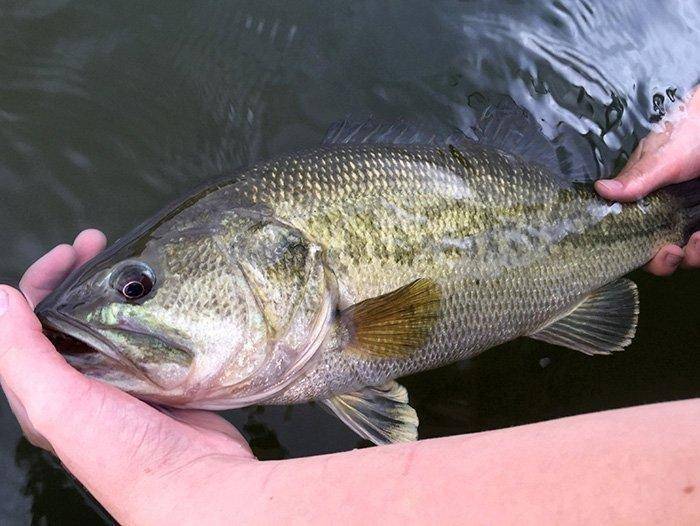For the past two years, DWR biologists have caught and kept largemouth bass at Steinaker Reservoir. The bass, along with bluegills from Steinaker, will help jumpstart the fishery at Pelican Lake.
DWR Press Release
Rotenone treatment will improve fishing
RANDLETT — The time has finally arrived to make positive changes at Pelican Lake: on Oct. 10 and 11, the Division of Wildlife Resources and its partners will release rotenone into the lake. The rotenone treatment will remove common carp. Removing the carp will improve water clarity and start the process of restoring the fishery.
Waiting for the right conditions
Pelican Lake is about 25 miles southeast of Roosevelt. Historically, it was ‘the place’ to go to catch big bluegill in Utah. It also hosted a healthy population of largemouth bass. After an influx of large numbers of common carp in 2008 and 2009, however, the quality of the bluegill fishery declined rapidly.
Trina Hedrick, regional aquatics manager for the DWR, says the treatment has been anticipated for years.
“In 2016,” she says, “agency representatives and anglers that make up the Pelican Lake Management Team made the decision to remove common carp from the lake. The only way to completely eradicate carp is through the use of rotenone. We needed to wait for low water levels, though, to ensure no carp escaped the treatment. This year’s drought dropped the lake to the target water levels. It’s time to treat it.”
Treating the lake
Rotenone is a natural substance that comes from the roots of a tropical plant in the bean family. It’s a piscicide (a substance poisonous to fish), but it does not pose a risk to people, pets or wildlife.
Rotenone will be applied throughout the lake, and it will have an immediate effect. Within a few hours, the fish will be dead, and clean-up will begin. Hedrick says the lake will be signed and closed to the public from Oct. 10 to Oct. 31.
By the end of October, the rotenone will have completely dissipated. Restocking will begin once water starts running into the lake from a nearby canal. Luckily, biologists already have a population of fish to stock into the lake.
“We’ve been holding large bass and healthy bluegill that we took from Steinaker Reservoir over the past two years,” she says. “We can begin stocking the lake once it starts refilling with water. In addition to increasing the water level, the inflow will bring bugs and other food for fish into the reservoir. The rotenone treatment will reduce the amount of food in the lake, but the food supply should increase quickly as water flows in.”
At first, biologists will stock mostly bluegill. “Largemouth prey on bluegill,” Hedrick says, “so we need to keep largemouth bass numbers low to give the bluegill population time to establish itself.”
Hedrick asks anglers to be patient. “After the treatment this fall,” she says, “it will take a few years for fish in the lake to grow to a catchable size. The wait will be worth it in the end, though.”
What to expect during the treatment
Depending on the temperature and wind direction, homeowners around the lake may notice the smell of decaying fish after the treatment is over. “Only about 30 percent of the fish will float to the top of the water with the rest sinking to the bottom,” Hedrick says. “That will reduce the smell, but it will be present for awhile.”
Hedrick says biologists will spend a few days removing dead fish, but there will be too many to remove them all.
Recreation and waterfowl hunting
Pelican Lake is a great place to recreate, whether you’re boating, fishing, camping or hunting. This year’s treatment will close the lake to all recreational use, from Oct. 10 through Oct. 31.
Though the boat ramps will be closed, the Bureau of Land Management will keep the campground on the south side of the lake open. During the closure, Brough Reservoir and the Green River will be the next closest places to fish or boat. Launching a boat at either water is difficult in the fall, though.
The lake is also a hotspot for migratory birds — especially waterfowl — to stop and refuel as they travel south for the winter season. This closure happens to fall in the middle of waterfowl hunting season. While the lake is closed, waterfowl hunters will want to plan ahead and look for hunting areas elsewhere in the Uintah Basin.
Keep some fish
Before the treatment starts on Oct. 10, Hedrick encourages you to visit Pelican Lake and fish. Currently, there’s no limit on the number of bluegill you can keep. And the largemouth bass limit has been doubled to 12 fish a day. For more information, call the DWR’s Northeastern Region office at 435-781-9453.

